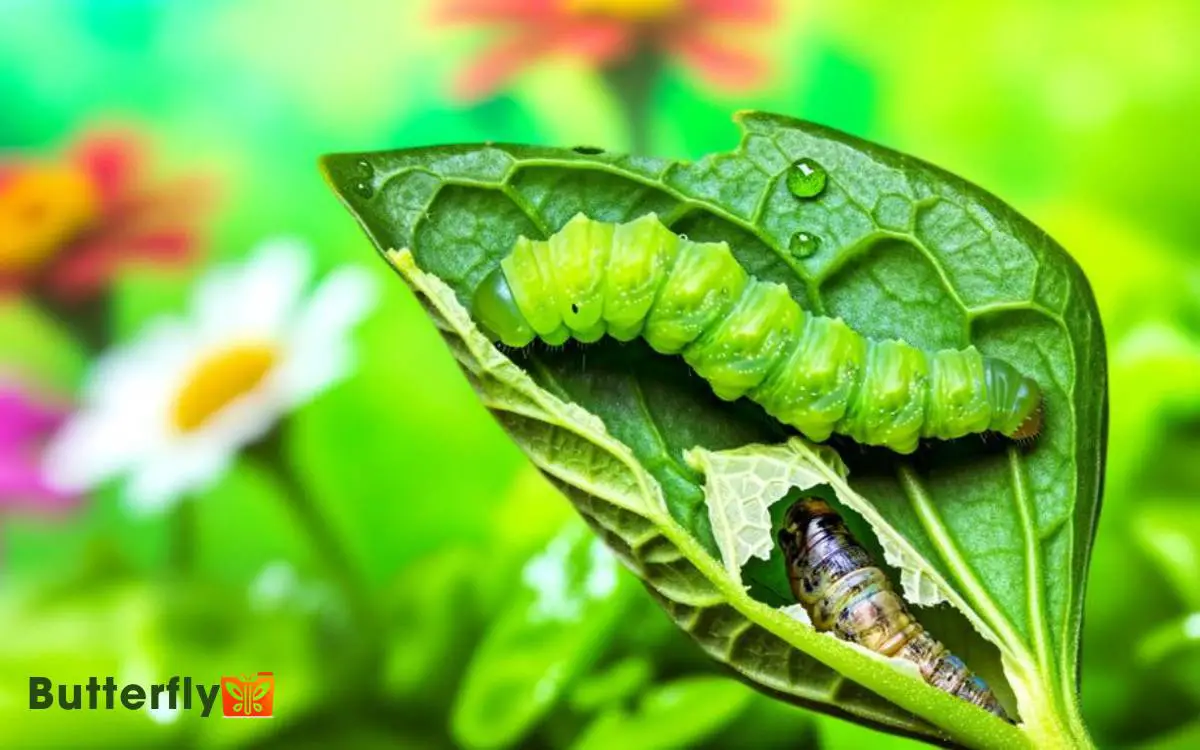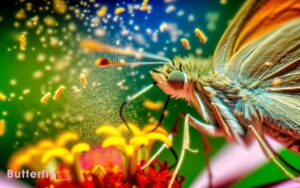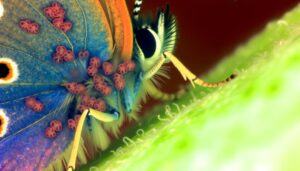Do Cankerworms Turn Into Butterflies? Discover the Truth!
Cankerworms don’t evolve into butterflies; they metamorphose into geometrid moths. During their life cycle, they progress from eggs laid on tree bark, to larvae that move in an inchworm-like manner.
These larvae, adept at camouflage and significant defoliation, evolve through pupa stage inside protective cocoons where histolysis and histogenesis occur breaking down larval tissues and forming adult structures.
The adult stage reveals them as geometrid moths, distinctly different from butterflies due to their wing patterns and body structures. Discover more about their fascinating transformation and unique characteristics of each life stage.

Key Takeaways
What Are Cankerworms?
Cankerworms, commonly known as inchworms, are larvae of geometrid moths that belong to the family Geometridae.
You’ll notice their unique movement: a looping gait caused by the absence of middle prolegs. These larvae are adept at camouflage, often blending in with leaves and twigs.
They primarily feed on the foliage of deciduous trees, such as oaks and elms, causing significant defoliation during outbreaks.
Their bodies can vary in color, typically ranging from green to brown, and feature longitudinal stripes that enhance their mimicry. As a defense mechanism, some species can drop on silk threads when disturbed.
Understanding these larvae’s physical characteristics and behaviors is vital for effective management in forestry and urban landscapes.
Cankerworm Life Cycle
Understanding their life cycle reveals how these larvae transform from tiny, leaf-munching inchworms into adult geometrid moths.
You’ll see that cankerworms progress through distinct stages: egg, larva, pupa, and adult. Each stage has unique characteristics and functions, contributing to their development.
| Stage | Description | Duration |
|---|---|---|
| Egg | Laid on tree bark, dormant | Few weeks |
| Larva | Active feeding, inchworm-like | 4-6 weeks |
| Pupa | Inactive, cocoon formation | Several months |
During the larval stage, cankerworms voraciously consume foliage, impacting tree health. As pupae, they retreat to the soil, remaining inactive while their adult form develops.
Finally, they emerge as moths, completing the cycle and starting it anew. Understanding these stages helps in managing and studying their ecological impact.
The Egg Stage
When adult female moths lay their eggs on tree bark, they set the stage for the next generation of cankerworms. You’ll notice these eggs are tiny, oval, and often clustered in large groups. They’re usually deposited in late fall or early spring, depending on the species.
The eggs are initially pale, often changing to a darker hue as they mature. This color shift indicates developing embryos inside. During the overwintering period, the eggs remain dormant, protected by the tree bark’s crevices.
In spring, rising temperatures signal the eggs to hatch. By understanding this egg stage, you can better appreciate the intricate life cycle of cankerworms and the natural cues that dictate their development.
Larval Stage Details
After hatching, the larval stage of cankerworms begins with the emergence of tiny, inchworm-like caterpillars that immediately start feeding on the foliage of their host trees.
You’ll notice these larvae exhibit looping movements due to their lack of middle legs. They have distinct color patterns, ranging from green to brown, aiding in camouflage.
The primary focus during this stage is rapid growth and consumption of leaves, which can lead to significant defoliation.
Here’s a quick overview:
| Characteristic | Observation | Function |
|---|---|---|
| Movement | Inchworm-like | Efficient locomotion |
| Color | Green/Brown | Camouflage |
| Feeding | Foliage | Rapid growth |
Understanding these details helps you grasp the importance of the larval stage in the lifecycle of cankerworms.
Pupa Stage Insights
As the larvae reach maturity, they enter the pupa stage, during which they undergo a remarkable metamorphosis within silken cocoons buried in the soil.
During this phase, profound physiological transformations occur. The larval tissues break down through histolysis, allowing adult structures to form via histogenesis. This period of dormancy is essential for the development of the adult insect.
Key processes occurring at the pupa stage include:
- Histolysis: Breakdown of larval tissues.
- Histogenesis: Formation of adult structures.
- Hormonal Regulation: Ecdysteroids and juvenile hormones guide development.
- Protective Measures: Cocoons shield from environmental hazards.
Understanding these processes helps you appreciate the complexity of metamorphosis and the pupa’s role in the insect’s life cycle.
Adult Form Unveiled
You’ll observe that cankerworms undergo a remarkable metamorphosis, emerging as adult butterflies with distinct morphological traits. However, cankerworms actually develop into moths rather than butterflies, despite some common misconceptions. This raises an interesting question: can moths become butterflies, or are they entirely separate in their evolutionary paths? While both belong to the order Lepidoptera, their differences in wing structure, behavior, and life cycles distinguish them as unique groups.
Pay close attention to the wing patterns and antenna structures, which are key identifying characteristics.
These features not only aid in species identification but also play pivotal roles in their ecological interactions.
Cankerworm Adult Transformation
Emerging from their pupal stage, cankerworms metamorphose into adult moths, revealing intricate wing patterns and structural adaptations.
As you observe these transformations, note the following key aspects:
- Wing Patterns: Moth wings display diverse colorations and patterns, essential for camouflage.
- Antennae: Their antennae are highly sensitive, aiding in navigation and pheromone detection.
- Reproductive Structures: Adapted for mating, ensuring the continuation of the species.
- Flight Musculature: Developed muscles enable efficient flight for foraging and evasion.
These moths exhibit remarkable traits that play significant roles in their survival and reproductive success. Understanding these elements enhances your appreciation of their complex life cycle and the precise biological processes governing their metamorphosis.
Identifying Adult Characteristics
Upon close examination, you can identify adult cankerworms by their distinct wing patterns, which serve as both camouflage and a signal to potential mates.
The male cankerworm moths possess rudimentary, mottled wings, aiding in blending with tree bark. In contrast, female cankerworms are wingless, a unique adaptation among moths.
Their bodies are elongated and cylindrical, with a series of abdominal segments distinctly visible. You’ll notice their antennae are filiform, contributing to heightened sensory perception.
The sexual dimorphism in cankerworms is a key identification trait, with males exhibiting more prominent, albeit subtle, physical features.
Understanding these morphological characteristics aids in differentiating cankerworms from butterflies, which possess vibrant, fully-developed wings and markedly different body structures.
Differences From Butterflies
You’ll notice key differences between cankerworms and butterflies in their lifecycles and physical characteristics.
Cankerworms, for instance, undergo a complete metamorphosis but their pupation occurs in the soil, unlike many butterflies.
Additionally, cankerworm adults are typically less vibrant and lack the distinctive wing patterns seen in butterflies.
Lifecycle Variations
Unlike butterflies, cankerworms undergo significant lifecycle variations. Notable differences exist in their metamorphosis stages and seasonal behavior.
You’ll find that cankerworms, which are actually the larvae of moths, exhibit a unique lifecycle:
- Egg Stage: Cankerworms lay eggs in late fall or early spring, while butterflies typically lay eggs during warmer months.
- Larval Stage: The larvae emerge in early spring and feed voraciously on tree leaves, a critical difference from butterfly caterpillars, which emerge later.
- Pupal Stage: Cankerworms pupate in the soil, contrasting with butterfly chrysalides that hang from plants.
- Adult Stage: Adult cankerworms are moths, not butterflies, and exhibit nocturnal behavior, unlike the diurnal activity of butterflies.
Understanding these lifecycle distinctions helps you appreciate the ecological roles and behaviors of cankerworms.
Physical Characteristics
Cankerworms, unlike butterflies, exhibit distinct physical characteristics such as elongated, inchworm-like larvae and drab-colored adult moths.
When you observe cankerworm larvae, you’ll notice their unique locomotion: they move in a looping manner, creating a characteristic ‘inchworm’ movement. Their bodies are elongated and lack the vibrant colors found in butterfly caterpillars.
As adults, cankerworms transform into moths with muted, brown or gray hues, lacking the striking, colorful wings of butterflies.
Additionally, cankerworm moths possess a more robust, hairy body compared to the slender, smooth bodies of butterflies.
Male cankerworm moths have feathery antennae, while females often exhibit vestigial wings, rendering them flightless, a stark contrast to the functional wings seen in female butterflies.
Conclusion
To sum up, while cankerworms and butterflies share intriguing life cycles, they diverge at the adult stage. You’ll notice cankerworms metamorphose into moths, not butterflies.
The delicate, colorful wings of butterflies starkly contrast the more subdued, earth-toned wings of moths. This juxtaposition highlights their evolutionary paths.
By understanding these differences, you’re better equipped to appreciate the intricate nuances of Lepidoptera, where every species, whether moth or butterfly, plays a unique role in our ecosystem.







Your point of view caught my eye and was very interesting. Thanks. I have a question for you.
Thanks for sharing. I read many of your blog posts, cool, your blog is very good.
I don’t think the title of your article matches the content lol. Just kidding, mainly because I had some doubts after reading the article.
Your point of view caught my eye and was very interesting. Thanks. I have a question for you.
Your enticle helped me a lot, is there any more related content? Thanks! https://www.binance.info/join?ref=IJFGOAID
Thank you for your sharing. I am worried that I lack creative ideas. It is your article that makes me full of hope. Thank you. But, I have a question, can you help me?
Thank you for your sharing. I am worried that I lack creative ideas. It is your article that makes me full of hope. Thank you. But, I have a question, can you help me?
Your article helped me a lot, is there any more related content? Thanks!
I don’t think the title of your article matches the content lol. Just kidding, mainly because I had some doubts after reading the article.